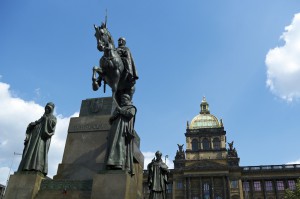Wenceslas Square (Václavské náměstí)
By Dominique Mohaud Spalovsky
Witness to history
If Wenceslas Square could talk it would have a lot to say. As the silent eyes of a nation, it has witnessed a great deal of Czech history – from its humble beginnings as a horse market in medieval times to a giant Mass held during the revolutionary upheavals of 1848 to the celebration of the creation of the new Czechoslovak Republic in 1918 to the peaceful Velvet Revolution of 1989 to its present-day status as the meeting place of choice for Czech citizens and tourists alike.
Wenceslas Square is a contradiction of styles: beautiful Art Nouveau edifices and baroque architecture are juxtaposed with faceless Soviet-era department stores.
 Statue of St. Wenceslas
Statue of St. Wenceslas
At the southern end of the square is Josef Myslbek’s muscular equestrian statue of St Wenceslas, the 10th-century pacifist Duke of Bohemia, the patron saint of the Czech Republic and the ‘Good King Wenceslas’ of Christmas carol fame. Near the statue is a small memorial to the victims of communism and bears photographs and handwritten epitaphs to Jan Palach, the young student who set himself on fire to protest against the “demoralization” of Czechoslovakian citizens caused by the Soviet occupation, and other anti-communist rebels.
Wenceslas Square today
In sharp contrast to its recent history and the solemnity of the shrine, Wenceslas Square has become a monument to capitalism and is encased by upmarket hotels, fast food outlets, nightclubs, foreign exchange offices, and international clothing shops, restaurants, and bars.
National Museum
At the top end of the square is the National Museum, a monumental neo-renaissance building from the end of the 19th century that overlooks the whole square. It is the oldest museum in Bohemia and today the most distinguished and largest museum in the Czech Republic. A few minutes’ walks from the National Museum is The Prague State Opera, where patrons can enjoy a varied repertoire of opera and ballet. To the west is the trendy district known as SoNa (‘South of the National Theatre’). Here you will find designers, artists, writers, and media types, drawn to the area by the more alternative scene visible in the area’s many bars and restaurants. To the east is a quieter, more residential area where small shops cater to local clientele.
Centrally located, one can get to all of Prague’s main sights and attractions from Wenceslas Square on foot. Many city tour busses depart from the square and it is flanked by two metro stations, Mustek and Museum.
Vibrant and steeped in history, Wenceslas Square is a vital part of any local or tourist’s itinerary.



